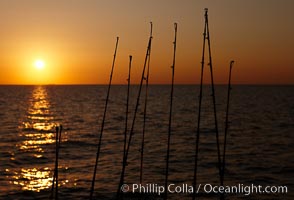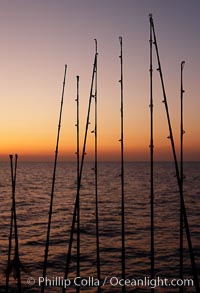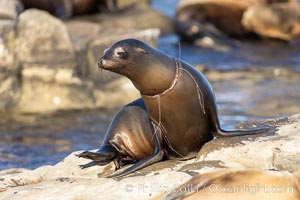
California sea lion entangled in fishing line, deep laceration around neck, Point La Jolla.
Species: California, Zalophus californianus
Location: La Jolla, California
Image ID: 37833
Species: California, Zalophus californianus
Location: La Jolla, California
Image ID: 37833
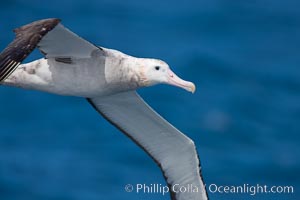
Wandering albatross in flight, over the open sea. The wandering albatross has the largest wingspan of any living bird, with the wingspan between, up to 12' from wingtip to wingtip. It can soar on the open ocean for hours at a time, riding the updrafts from individual swells, with a glide ratio of 22 units of distance for every unit of drop. The wandering albatross can live up to 23 years. They hunt at night on the open ocean for cephalopods, small fish, and crustaceans. The survival of the species is at risk due to mortality from long-line fishing gear.
Species: Wandering albatross, Diomedea exulans
Location: Southern Ocean
Image ID: 24070
Species: Wandering albatross, Diomedea exulans
Location: Southern Ocean
Image ID: 24070
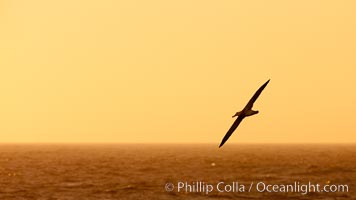
Wandering albatross in flight, over the open sea. The wandering albatross has the largest wingspan of any living bird, with the wingspan between, up to 12' from wingtip to wingtip. It can soar on the open ocean for hours at a time, riding the updrafts from individual swells, with a glide ratio of 22 units of distance for every unit of drop. The wandering albatross can live up to 23 years. They hunt at night on the open ocean for cephalopods, small fish, and crustaceans. The survival of the species is at risk due to mortality from long-line fishing gear.
Species: Wandering albatross, Diomedea exulans
Location: Southern Ocean
Image ID: 24092
Species: Wandering albatross, Diomedea exulans
Location: Southern Ocean
Image ID: 24092
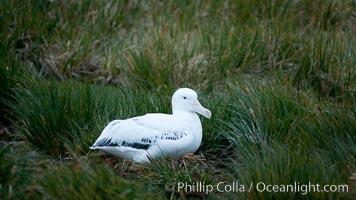
Wandering albatross, on nest in the Prion Island colony. The wandering albatross has the largest wingspan of any living bird, with the wingspan between, up to 12' from wingtip to wingtip. It can soar on the open ocean for hours at a time, riding the updrafts from individual swells, with a glide ratio of 22 units of distance for every unit of drop. The wandering albatross can live up to 23 years. They hunt at night on the open ocean for cephalopods, small fish, and crustaceans. The survival of the species is at risk due to mortality from long-line fishing gear.
Species: Wandering albatross, Diomedea exulans
Location: Prion Island, South Georgia Island
Image ID: 24394
Species: Wandering albatross, Diomedea exulans
Location: Prion Island, South Georgia Island
Image ID: 24394
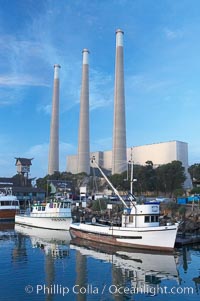
The Morro Bay Power Plant, with its distinctive three stacks, rises above fishing boats in Morro Bay harbor. Morro Bay.
Location: Morro Bay, California
Image ID: 14900
Location: Morro Bay, California
Image ID: 14900
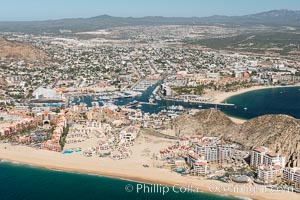
Cabo San Lucas, marina and downtown, showing extensive development and many resorts and sport fishing boats.
Location: Cabo San Lucas, Baja California, Mexico
Image ID: 28889
Location: Cabo San Lucas, Baja California, Mexico
Image ID: 28889
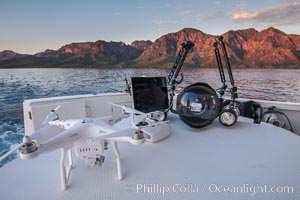
Toys: Drone, Underwater Camera Housing, Fishing Rod and SCUBA tanks.
Location: San Evaristo, Baja California, Mexico
Image ID: 32423
Location: San Evaristo, Baja California, Mexico
Image ID: 32423

Fishing Pinks in Breaking Waves, Hendrik Willem Mesdag, c. 1875 - c. 1885, oil paint, h 90cm x w 181cm x w 41.8kg.
Location: Rijksmuseum, Amsterdam, Holland, Netherlands
Image ID: 29472
Location: Rijksmuseum, Amsterdam, Holland, Netherlands
Image ID: 29472
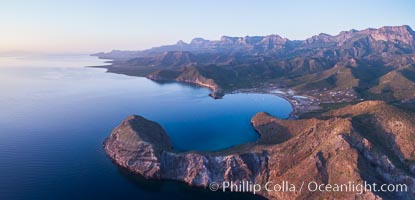
San Evaristo at dawn, panoramic view, a small fishing town, aerial photo, Sea of Cortez, Baja California.
Location: San Evaristo, Baja California, Mexico
Image ID: 33488
Location: San Evaristo, Baja California, Mexico
Image ID: 33488
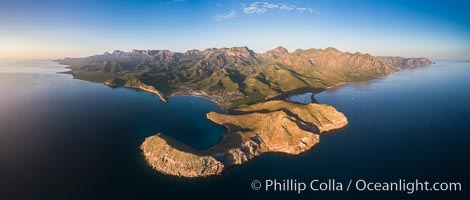
San Evaristo at dawn, panoramic view, a small fishing town, aerial photo, Sea of Cortez, Baja California.
Location: San Evaristo, Baja California, Mexico
Image ID: 37323
Panorama dimensions: 5201 x 12215
Location: San Evaristo, Baja California, Mexico
Image ID: 37323
Panorama dimensions: 5201 x 12215
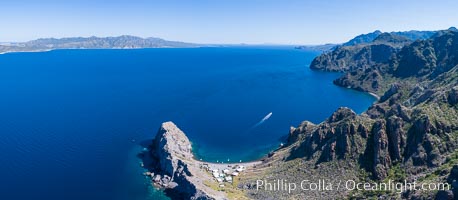
Punta Alta, a small fishing village, Aerial View, Sea of Cortez.
Location: Baja California, Mexico
Image ID: 37332
Location: Baja California, Mexico
Image ID: 37332
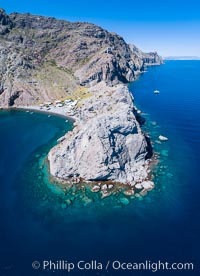
Punta Alta, a small fishing village, Aerial View, Sea of Cortez.
Location: Baja California, Mexico
Image ID: 37366
Location: Baja California, Mexico
Image ID: 37366
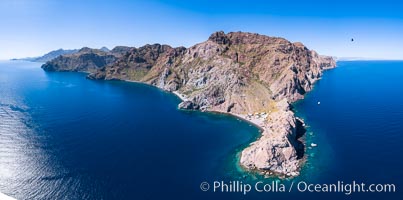
Punta Alta, a small fishing village, Aerial View, Sea of Cortez.
Location: Baja California, Mexico
Image ID: 37367
Panorama dimensions: 5702 x 11504
Location: Baja California, Mexico
Image ID: 37367
Panorama dimensions: 5702 x 11504
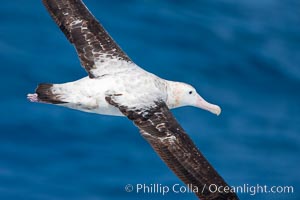
Wandering albatross in flight, over the open sea. The wandering albatross has the largest wingspan of any living bird, with the wingspan between, up to 12' from wingtip to wingtip. It can soar on the open ocean for hours at a time, riding the updrafts from individual swells, with a glide ratio of 22 units of distance for every unit of drop. The wandering albatross can live up to 23 years. They hunt at night on the open ocean for cephalopods, small fish, and crustaceans. The survival of the species is at risk due to mortality from long-line fishing gear.
Species: Wandering albatross, Diomedea exulans
Location: Southern Ocean
Image ID: 24087
Species: Wandering albatross, Diomedea exulans
Location: Southern Ocean
Image ID: 24087
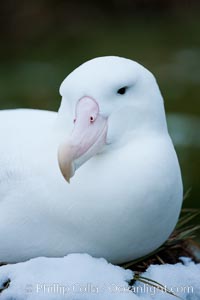
Wandering albatross, on nest and the Prion Island colony. The wandering albatross has the largest wingspan of any living bird, with the wingspan between, up to 12' from wingtip to wingtip. It can soar on the open ocean for hours at a time, riding the updrafts from individual swells, with a glide ratio of 22 units of distance for every unit of drop. The wandering albatross can live up to 23 years. They hunt at night on the open ocean for cephalopods, small fish, and crustaceans. The survival of the species is at risk due to mortality from long-line fishing gear.
Species: Wandering albatross, Diomedea exulans
Location: Prion Island, South Georgia Island
Image ID: 24428
Species: Wandering albatross, Diomedea exulans
Location: Prion Island, South Georgia Island
Image ID: 24428
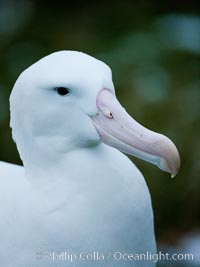
Wandering albatross, on nest and the Prion Island colony. The wandering albatross has the largest wingspan of any living bird, with the wingspan between, up to 12' from wingtip to wingtip. It can soar on the open ocean for hours at a time, riding the updrafts from individual swells, with a glide ratio of 22 units of distance for every unit of drop. The wandering albatross can live up to 23 years. They hunt at night on the open ocean for cephalopods, small fish, and crustaceans. The survival of the species is at risk due to mortality from long-line fishing gear.
Species: Wandering albatross, Diomedea exulans
Location: Prion Island, South Georgia Island
Image ID: 24429
Species: Wandering albatross, Diomedea exulans
Location: Prion Island, South Georgia Island
Image ID: 24429
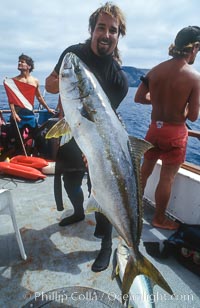
Yellowtail fishing, Guadalupe Island, Mexico.
Location: Guadalupe Island (Isla Guadalupe), Baja California, Mexico
Image ID: 01977
Location: Guadalupe Island (Isla Guadalupe), Baja California, Mexico
Image ID: 01977
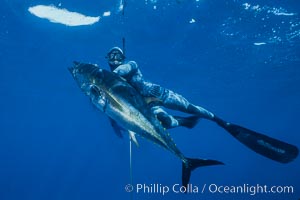
Spearfishing, Guadalupe Island, Mexico.
Location: Guadalupe Island (Isla Guadalupe), Baja California, Mexico
Image ID: 36166
Location: Guadalupe Island (Isla Guadalupe), Baja California, Mexico
Image ID: 36166
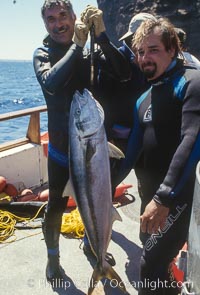
Spearfishing, Guadalupe Island, Mexico.
Location: Guadalupe Island (Isla Guadalupe), Baja California, Mexico
Image ID: 36205
Location: Guadalupe Island (Isla Guadalupe), Baja California, Mexico
Image ID: 36205
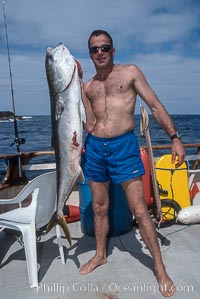
Spearfishing, Guadalupe Island, Mexico.
Location: Guadalupe Island (Isla Guadalupe), Baja California, Mexico
Image ID: 36206
Location: Guadalupe Island (Isla Guadalupe), Baja California, Mexico
Image ID: 36206
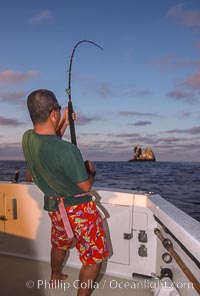
Fishing for giant yellowfin tuna at Roca Partida in the Revillagigedos, Baja California, Mexico. This is a historical photo; the Revillagigedos Island group is now protected and fishing is not permitted at the islands.
Location: Socorro Island (Islas Revillagigedos), Baja California, Mexico
Image ID: 36212
Location: Socorro Island (Islas Revillagigedos), Baja California, Mexico
Image ID: 36212
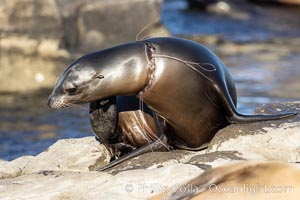
California sea lion entangled in fishing line, deep laceration around neck, Point La Jolla.
Species: California, Zalophus californianus
Location: La Jolla, California
Image ID: 37834
Species: California, Zalophus californianus
Location: La Jolla, California
Image ID: 37834
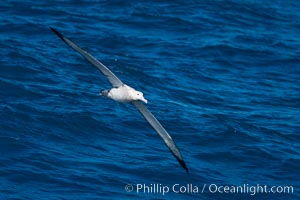
Wandering albatross in flight, over the open sea. The wandering albatross has the largest wingspan of any living bird, with the wingspan between, up to 12' from wingtip to wingtip. It can soar on the open ocean for hours at a time, riding the updrafts from individual swells, with a glide ratio of 22 units of distance for every unit of drop. The wandering albatross can live up to 23 years. They hunt at night on the open ocean for cephalopods, small fish, and crustaceans. The survival of the species is at risk due to mortality from long-line fishing gear.
Species: Wandering albatross, Diomedea exulans
Location: Southern Ocean
Image ID: 24088
Species: Wandering albatross, Diomedea exulans
Location: Southern Ocean
Image ID: 24088
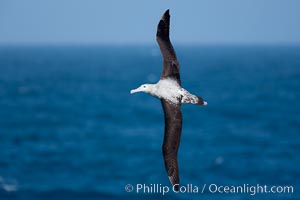
Wandering albatross in flight, over the open sea. The wandering albatross has the largest wingspan of any living bird, with the wingspan between, up to 12' from wingtip to wingtip. It can soar on the open ocean for hours at a time, riding the updrafts from individual swells, with a glide ratio of 22 units of distance for every unit of drop. The wandering albatross can live up to 23 years. They hunt at night on the open ocean for cephalopods, small fish, and crustaceans. The survival of the species is at risk due to mortality from long-line fishing gear.
Species: Wandering albatross, Diomedea exulans
Location: Southern Ocean
Image ID: 24089
Species: Wandering albatross, Diomedea exulans
Location: Southern Ocean
Image ID: 24089
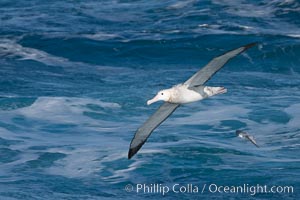
Wandering albatross in flight, over the open sea. The wandering albatross has the largest wingspan of any living bird, with the wingspan between, up to 12' from wingtip to wingtip. It can soar on the open ocean for hours at a time, riding the updrafts from individual swells, with a glide ratio of 22 units of distance for every unit of drop. The wandering albatross can live up to 23 years. They hunt at night on the open ocean for cephalopods, small fish, and crustaceans. The survival of the species is at risk due to mortality from long-line fishing gear.
Species: Wandering albatross, Diomedea exulans
Location: Southern Ocean
Image ID: 24090
Species: Wandering albatross, Diomedea exulans
Location: Southern Ocean
Image ID: 24090
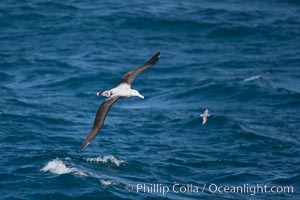
Wandering albatross in flight, over the open sea. The wandering albatross has the largest wingspan of any living bird, with the wingspan between, up to 12' from wingtip to wingtip. It can soar on the open ocean for hours at a time, riding the updrafts from individual swells, with a glide ratio of 22 units of distance for every unit of drop. The wandering albatross can live up to 23 years. They hunt at night on the open ocean for cephalopods, small fish, and crustaceans. The survival of the species is at risk due to mortality from long-line fishing gear.
Species: Wandering albatross, Diomedea exulans
Location: Southern Ocean
Image ID: 24133
Species: Wandering albatross, Diomedea exulans
Location: Southern Ocean
Image ID: 24133
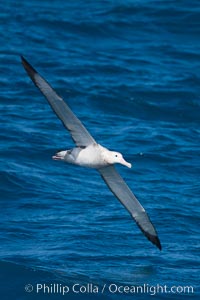
Wandering albatross in flight, over the open sea. The wandering albatross has the largest wingspan of any living bird, with the wingspan between, up to 12' from wingtip to wingtip. It can soar on the open ocean for hours at a time, riding the updrafts from individual swells, with a glide ratio of 22 units of distance for every unit of drop. The wandering albatross can live up to 23 years. They hunt at night on the open ocean for cephalopods, small fish, and crustaceans. The survival of the species is at risk due to mortality from long-line fishing gear.
Species: Wandering albatross, Diomedea exulans
Location: Southern Ocean
Image ID: 24169
Species: Wandering albatross, Diomedea exulans
Location: Southern Ocean
Image ID: 24169
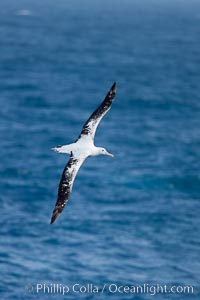
Wandering albatross in flight, over the open sea. The wandering albatross has the largest wingspan of any living bird, with the wingspan between, up to 12' from wingtip to wingtip. It can soar on the open ocean for hours at a time, riding the updrafts from individual swells, with a glide ratio of 22 units of distance for every unit of drop. The wandering albatross can live up to 23 years. They hunt at night on the open ocean for cephalopods, small fish, and crustaceans. The survival of the species is at risk due to mortality from long-line fishing gear.
Species: Wandering albatross, Diomedea exulans
Location: Southern Ocean
Image ID: 24170
Species: Wandering albatross, Diomedea exulans
Location: Southern Ocean
Image ID: 24170
